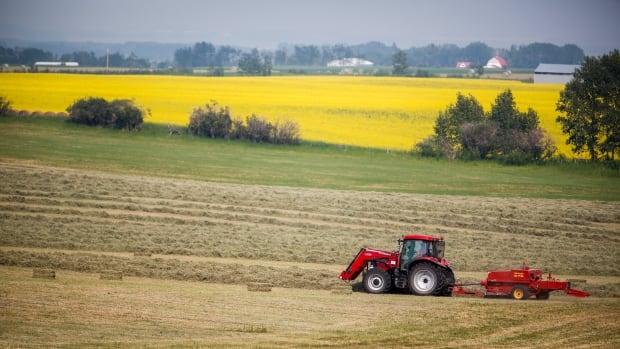At Jolene Noble’s family cattle farm near Manning, Alta., in the northwest Peace River region, there’s virtually no snow on the ground — something she said she has never seen before.
It comes after a hot summer where she didn’t see substantial rain until late July. Any moisture that added to the soil is now long gone.
Without more snow, Noble said there won’t be enough surface water runoff to refill the dugouts on their pasture.
“Everybody’s nervous,” she said.
“For spring and summer, the water for the cows, right now, it’s not there.”
Noble is among the many Alberta farmers and ranchers bracing for what could be another gruelling year of dry conditions as costs of the 2023 drought mount.
Drought can leave cattle farmers scrambling to find a way to feed their animals. They may face a choice between shouldering the cost of buying and transporting large amounts of feed, or selling off cattle to reduce their herd size — which also affects their bottom line.
Near Nanton in southern Alberta, where he runs a cow-calf operation, Bob Lowe said there’s finally some snow cover — but not enough. There’s very little snowpack on the mountains, too.
“The old saying is ‘Plan for a drought and hope for the best,’ right? But if you do that every year for a few years in the real world, pretty soon you don’t have a herd anymore,” Lowe said.
Pasture insurance payouts top $300M
Moisture deficiency insurance (MDI) — coverage for livestock producers in case their soil is too dry to grow feed or let their herd graze — hit a record-high $326.5 million in total payouts in the 2023 growing season.
Last season’s payouts more than tripled those made after the 2021 province-wide drought, according to the Agriculture Financial Services Corporation (AFSC), which administers government cost-shared loans and crop insurance for Alberta farmers.
MDI, sometimes also called pasture insurance, makes up a fraction of overall crop insurance coverage. The sum of all crop insurance claims for 2023 still isn’t finalized, but 2022 saw $1.25 billion in payouts. In 2021, payouts reached $2.75 billion.
Jesse Cole, manager of insurance products and innovation at AFSC, said there are a few reasons for the bigger MDI numbers in 2023, including some recent adjustments to how the program works and an uptick in people taking the coverage after the last major drought.
The deadline for getting MDI for the coming growing season is Feb. 29. Cole said there could likely be another increase in enrolment.
“Handling one of those years might be possible for people. Two of them may not have been an option,” he said.
Lowe and Noble each had claims for their MDI coverage in 2023. Lowe said the program isn’t perfect, but it’s a backup that has grown more necessary.
Last year he had to buy feed for his cattle and pay for it to be hauled by truck, he said.
Less-established producers on thinner margins “would not have a chance” if they are put in that situation without insurance, Lowe said.
“It would have killed you.”
Drought conditions persist across Alberta
Southern Alberta and the east-central Parkland area, where drought conditions have been especially dire, received 90 per cent of the MDI payouts.
Drought monitoring from Agriculture and Agri-Food Canada shows that’s still the case.

The latest data, from the end of January, suggests drought conditions in most of southern Alberta are “severe” or worse; part of the southeast is suffering “exceptional” drought — the worst classification.
Northwest Alberta is seeing problems too, with expanding areas of “severe” and “extreme” drought, data shows.
Agri-climate specialist Trevor Hadwen said 85 per cent of Alberta’s agricultural land is in drought — and more than half is rated as severe to extreme drought.
“We typically do not see a drought of [that] level continuing through the winter as strong as they have this year,” Hadwen said.
The driest months of the year are now ending, he said, so there’s a better chance of more precipitation coming up. But there isn’t a quick fix in regions where the drought is worse and has persisted longer.
“We need above-normal precipitation to make up some of those long-term deficits,” Hadwen said.
“We go into drought slowly. We come out of drought slowly as well, typically.”
Alberta Beef Producers chair Brodie Haugan is extremely concerned about the year ahead, taking that long recovery time into account.
The higher MDI payouts show the program is working for producers who need it, Haugan said, but producers are still pushing for changes to better cover the risk across the whole province.
While he and others wait for spring rain, the compounding effects of several dry years are a worry.
“Even if we have an average year, it’s going to be a difficult year for the industry,” he said.


